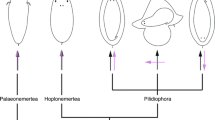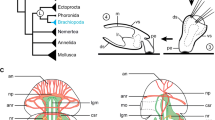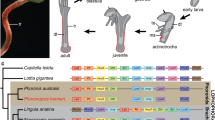Abstract
The bilaterian animals are divided into three great branches: the Deuterostomia, Ecdysozoa, and Lophotrochozoa. The evolution of developmental mechanisms is less studied in the Lophotrochozoa than in the other two clades. We have studied the expression of Hox genes during larval development of two lophotrochozoans, the polychaete annelids Nereis virens and Platynereis dumerilii. As reported previously, the Hox cluster of N. virens consists of at least 11 genes (de Rosa R, Grenier JK, Andreeva T, Cook CE, Adoutte A, Akam M, Carroll SB, Balavoine G, Nature, 399:772–776, 1999; Andreeva TF, Cook C, Korchagina NM, Akam M, Dondua AK, Ontogenez 32:225–233, 2001); we have also cloned nine Hox genes of P. dumerilii. Hox genes are mainly expressed in the descendants of the 2d blastomere, which form the integument of segments, ventral neural ganglia, pre-pygidial growth zone, and the pygidial lobe. Patterns of expression are similar for orthologous genes of both nereids. In Nereis, Hox2, and Hox3 are activated before the blastopore closure, while Hox1 and Hox4 are activated just after this. Hox5 and Post2 are first active during the metatrochophore stage, and Hox7, Lox4, and Lox2 at the late nectochaete stage only. During larval stages, Hox genes are expressed in staggered domains in the developing segments and pygidial lobe. The pattern of expression of Hox cluster genes suggests their involvement in the vectorial regionalization of the larval body along the antero-posterior axis. Hox gene expression in nereids conforms to the canonical patterns postulated for the two other evolutionary branches of the Bilateria, the Ecdysozoa and the Deuterostomia, thus supporting the evolutionary conservatism of the function of Hox genes in development.










Similar content being viewed by others
References
Ackermann C, Dorresteijn A, Fischer A (2005) Clonal domains in postlarval Platynereis dumerilii (Annelida: Polychaeta). J Morphol 266:258–280
Akam M (1995) Hox genes and the evolution of diverse body plans. Philos Trans R Soc Lond B Biol Sci 349:313–319
Akam M (1998) Hox genes, homeosis and the evolution of segment identity: no need for hopeless monsters. Int J Dev Biol 42:445–451
Aguinaldo AM, Turbeville JM, Linford LS, Rivera MC, Garey JR, Raff RA, Lake JA (1997) Evidence for a clade of nematodes, arthropods and other moulting animals. Nature 387:489–493
Anderson DT (1973) Embryology and phylogeny in annelids and arthropods. Oxford, Pergamon
Andreeva TF, Cook C, Korchagina NM, Akam M, Dondua AK (2001) Cloning and analysis of structural organization of Hox genes in the polychaete Nereis virens. Ontogenez 32:225–233
Arendt D (2003) Spiralians in the limelight. Genome Biol 5:303
Arendt D, Tessmar-Raible K, Snyman H, Dorresteijn AW, Wittbrodt J (2004) Ciliary photoreceptors with a vertebrate-type opsin in an invertebrate brain. Science 306:869–871
Bleidorn C, Vogt L, Bartolomaeus T (2003) New insight into polychaete phylogeny (Annelida) inferred from 18S rDNA sequences. Mol Phyl Evol 29:279–288
Brusca RC, Brusca GJ (2002) Invertebrates. Sinauer, Massachusetts
Callaerts P, Lee PN, Hartmann B, Farfan C, Choy DW, Ikeo K, Fischbach KF, Gehring WJ, de Couet HG (2002) Hox genes in the sepiolid squid Euprymna scolopes: implications for the evolution of complex body plans. Proc Natl Acad Sci USA 99:2088–2093
Carroll SB, Grenier JK, Weatherbee SD (2001) From DNA to Diversity: Molecular genetics and the evolution of animal design. Blackwell Science, Malden MA
Cho SJ, Cho PY, Lee MS, Hur, SY, Lee JA, Kim SK, Koh KS, Na YE, Choo JK, Kim CB, Park SC (2003) Hox genes from the earthworm Perionyx excavatus. Dev Genes Evol 213:207–210
Davidson EH (2001) Genomic regulatory systems: development and evolution. Academic, San Diego
Davidson EH, Peterson KJ, Cameron RA (1995) Origin of bilaterian body plans: evolution of developmental regulatory mechanisms. Science 24:1319–1325
de Rosa R, Grenier JK, Andreeva T, Cook CE, Adoutte A, Akam M, Carroll SB, Balavoine G (1999) Hox genes in brachiopods and priapulids and protostome evolution. Nature 399:772–776
Dondua AK (1975) Effect of actinomycin D and sibiromycin on the embryonic and larval development of Nereis virens. Ontogenez 6:475–484
Erwin DH, Davidson EH (2002) The last common bilaterian ancestor. Development 129:3021–3032
Ferrier DEK, Minguillon C (2003) Evolution of the Hox/ParaHox gene clusters. Int J Dev Biol 47:605–611
Fischer A, Dorresteijn A (2004) The polychaete Platynereis dumerilii (Annelida): a laboratory animal with spiralian cleavage, lifelong segment proliferation and a mixed benthic/pelagic life cycle. Bioessays 26:314–325
Hall KA, Hutchings PA, Colgan DJ (2004) Further phylogenetic studies of the Polychaeta using 18S rDNA sequence data. J Mar Biol Assoc UK 84:949–960
Hauenschild C, Fischer A (1969) Platynereis dumerilii. Grosses Zoologisches Praktikum, Heft 10b. Gustav Fischer Verlag, Stuttgart
Hinman VF, O’Brien EK, Richards GS, Degnan BM (2003) Expression of anterior Hox genes during larval development of the gastropod Haliotis asinina. Evol Dev 5:508–521
Irvine SQ, Martindale MQ (2000) Expression patterns of anterior Hox genes in the polychaete Chaetopterus: correlation with morphological boundaries. Dev Biol 217:333–351
Irvine SQ, Martindale MQ (2001) Comparative analysis of Hox gene expression in the polychaete Chaetopteus: implications for the evolution of body plan regionalization. Am Zool 41:640–651
Irvine SQ, Chaga O, Martindale MQ (1999) Larval ontogenetic stages of Chaetopterus: developmental heterochrony in the evolution of chaetopterid polychaetes. Biol Bull 197:319–331
Iwanoff PP (1928) Die Entwicklung der Larvalsegmente bei den Anneliden. Z Morphol Okol Tiere 10:62–161
Kmita-Cunisse M, Loosli F, Bierne J, Gehring WJ (1998) Homeobox genes in the ribbonworm Lineus sanguineus: evolutionary implications. Proc Natl Acad Sci USA 95:3030–3035
Kourakis MJ, Master VA, Lokhorst DK, Nardelli-Haefliger D, Wedeen CJ, Martindale MQ, Shankland M (1997) Conserved anterior boundaries of Hox gene expression in the central nervous system of the leech Helobdella. Dev Biol 190:284–300
Kulakova MA, Kostyuchenko RP, Andreeva TF, Dondua AK (2002) The Abdominal-B-like gene expression during larval development of Nereis virens (Polychaeta). Mech Dev 115:177–179
Lee PN, Callaerts P, de Couet HG, Martindale MQ (2003) Cephalopod Hox genes and the origin of morphological novelties. Nature 424:1061–1065
Nardelli-Haefliger D, Shankland M (1992) Lox2, a putative leech segment identity gene, is expressed in the same segmental domain in different stem cell lineages. Development 116:697–710
Nardelli-Haefliger D, Bruce AE, Shankland M (1994) An axial domain of HOM/Hox gene expression is formed by morphogenetic alignment of independently specified cell lineages in the leech Helobdella. Development 120:1839–1849
Nielsen C (2004) Trochophore larvae: cell-lineages, ciliary bands and body regions. 1. Annelida and mollusca. J Exp Zool (Mol Dev Evol) 302:35–68
Nogi T, Watanabe K (2001) Position-specific and non-colinear expression of the planarian posterior (Abdominal-B-like) gene. Dev Growth Differ 43:177–184
Peterson KJ, Davidson EH (2000) Regulatory evolution and the origin of the bilaterians. Proc Natl Acad Sci USA 97:4430–4433
Peterson KJ, Cameron RA, Davidson EH (2000a) Bilaterian origins: significance of new experimental observations. Dev Biol 219:1–17
Peterson KJ, Irvine SQ, Cameron RA, Davidson EH (2000b) Quantitative assessment of Hox complex expression in the indirect development of the polychaete annelid Chaetopterus sp. Proc Natl Acad Sci USA 97:4487–4492
Philippe H, Lartillot N, Brinkmann H (2005) Multigene analyses of bilaterian animals corroborate the monophyly of Ecdysozoa, Lophotrochozoa, and Protostomia. Mol Biol Evol 22:1246–1253
Raible F, Tessmar-Raible K, Osoegawa K, Wincker P, Jubin C, Balavoine G, Ferrier D, Benes V, de Jong P, Weissenbach J, Bork P, Arendt D (2005) Vertebrate-type intron-rich genes in the marine annelid Platynereis dumerilii. Science 310:1325–1326
Seo HC, Edvardsen RB, Maelandi AD, Bjordal M, Jensen MF, Hansen A, Flaat M, Weissenbach J, Lehrach H, Wincker P, Reinhardt R, Chourrout D (2004) Hox cluster disintegration with persistent anteroposterior order of expression in Oikopleura dioica. Nature 431:67–71
Seaver EC, Kanashige LM (2006) Expression of “segmentation” genes during larval and juvenile development in the polychaetes Capitella sp. and H. elegans. Dev Biol 289:179–194
Seaver EC, Thamm K, Hill SD (2005) Growth patterns during segmentation in the two polychaete annelids, Capitella sp. I and Hydroides elegans: comparisons at distinct life history stages. Evol Dev 7:312–326
Shankland M, Seaver EC (2000) Evolution of the bilaterian body plan: what have we learned from annelid? Proc Natl Acad Sci USA 97:4434–4437
Slack JMW, Holland PWH, Graham CF (1993) The zootype and the phylotypic stage. Nature 361:490–492
Telford MJ (2000) Turning Hox “signatures” into synapomorphies. Evol Dev 2:360–364
Tessmar-Raible K, Arendt D (2003) Emerging systems: between vertebrates and arthropods, the Lophotrochozoa. Curr Opin Genet Dev 13:331–340
Ushakov PV (1972) Polychaete worms. 1. Fauna of SSSR. Nauka, Leningrad
Wilson EB (1892) The cell lineage of Nereis. J Morph 6:361–480
Acknowledgements
The authors thank Mrs. Zh. E. Fedorova for assistance in establishing nereid cultures and the group, “Chromas,” in the Biological Institute of Saint-Petersburg University for allowing the use of the core facility equipment. We also thank Dr. T. Bosch and Dr. E. Davidson for the careful reading of the manuscript and for the useful remarks. Thanks are due to A. Nesterenko for the help with the paper preparation. This work was supported by the Russian Foundation for Basic Research Grant no. 06-04-49654-a and by the Biotechnology and Biological Sciences Research Council of the UK.
Author information
Authors and Affiliations
Corresponding author
Additional information
Communicated by D. A. Weisblat
Milana Kulakova, Nadezhda Bakalenko and Elena Novikova contributed equally to this work.
Rights and permissions
About this article
Cite this article
Kulakova, M., Bakalenko, N., Novikova, E. et al. Hox gene expression in larval development of the polychaetes Nereis virens and Platynereis dumerilii (Annelida, Lophotrochozoa). Dev Genes Evol 217, 39–54 (2007). https://doi.org/10.1007/s00427-006-0119-y
Received:
Accepted:
Published:
Issue Date:
DOI: https://doi.org/10.1007/s00427-006-0119-y




